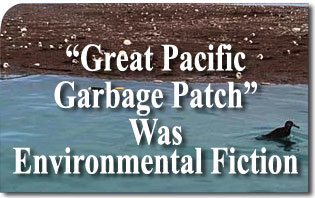 Once upon a time there was a huge island of trash floating in the Pacific. Only an island? No, a subcontinent! To believe the environmental movement, it spanned about 270,000 to 5.8 million square miles, i.e., one or two times the size of the U.S. (cf. Wikipedia, Great Pacific garbage patch). But why only one island? Why not a whole group of islands contaminating the world’s largest ocean?
Once upon a time there was a huge island of trash floating in the Pacific. Only an island? No, a subcontinent! To believe the environmental movement, it spanned about 270,000 to 5.8 million square miles, i.e., one or two times the size of the U.S. (cf. Wikipedia, Great Pacific garbage patch). But why only one island? Why not a whole group of islands contaminating the world’s largest ocean?
The boundless “plastic mass” generated by capitalist consumerism (claimed to be, after all, the only one that could have produced such a monster…) was said to have counterparts in other oceans and seas.
Fish of various species were dying and bordered on extinction. Oceans, once populated with friendly living beings, were becoming acid, losing oxygen, and being turned into liquid deserts.
Something so immense and serious should have been noticed by someone somewhere, at some point and in some way.
But, in fact, it was never seen but merely reported, in vague observations by travelers and sportsmen. Not even satellites were able to photograph it. As far as our incorrigible environmentalists were concerned, the characteristics of this colossal killer waste prevented it from being photographed.
The “Great Pacific Garbage Patch” was first imagined in February 2008 by someone on the BBC website, and in the British newspaper, The Independent.
The terrifying scarecrow was glossed by sensationalist media, committed to spreading environmentally apocalyptic scenarios.
But no one had ever analyzed, measured it, or provided a solid scientific opinion. Nor would the “greens” ever do something that might cool anti-capitalist fervor.
Their amazing imagination motivated Spain’s Superior Council of Scientific Research (CSIC, or Consejo Superior de Investigaciones Científicas), the country’s largest public institution dedicated to scientific research and the third most important one in Europe, to check things out.
The CSIC then financed “the largest interdisciplinary project on global [climate] change ever carried out,” according to Madrid’s newspaper El País.
The total budget was $7.3 million, in addition to expenses with two oceanographic ships of the Spanish Navy, the Hesperides and the Sarmiento de Gamboa.
The work involved circumnavigating the planet between 2010 and 2011 (35,000 nautical miles) and was called the “Malaspina Project,” in memory of the historic eighteenth century expedition of scientist Alejandro Malaspina.
The expedition was led by oceanographer Carlos Duarte, who presented its results to 80 scientists gathered for the purpose in Barcelona in September 2014.
“This famous island of plastics that supposedly floated between the U.S. coasts of Oregon and Hawaii does not exist,” Carlos Duarte peremptorily stated.
He explained that there are five large accumulations of plastic waste in the open ocean in isolated areas where ocean circulation concentrates contamination, but that it is not an island, not even five islets.
“It is not the much-talked about island,” Duarte concluded.

